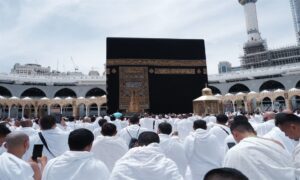When a pilgrim begins the rites of Hajj or Umrah, the very first physical act is the wearing of the Ihram — two simple pieces of unstitched white cloth for men, and modest clothing free of adornment for women. At first glance, this act might seem like a uniform or mere tradition. But in truth, Ihram is a symbol, a state of being, and a spiritual transformation.
It’s not just about what you wear. It’s about why you wear it — and who you become when you do.
Ihram: A Declaration of Spiritual Readiness
The word Ihram comes from the Arabic root ḥ-r-m, meaning “to forbid.” Upon donning Ihram, a pilgrim enters a sacred state where certain actions become prohibited — cutting hair, engaging in arguments, harming animals, even plucking a blade of grass. This change is not arbitrary; it represents a shift from worldly distractions to sacred focus.
“That [is so]. And whoever honors the symbols of Allah – indeed, it is from the piety of hearts.”
— Surah Al-Hajj (22:32)
لَبَّيْكَ ٱللَّٰهُمَّ لَبَّيْكَ، لَبَّيْكَ لَا شَرِيكَ لَكَ لَبَّيْكَ، إِنَّ ٱلْحَمْدَ وَٱلنِّعْمَةَ لَكَ وَٱلْمُلْكَ لَا شَرِيكَ لَكَ
The moment a pilgrim says “Labbayk Allahumma labbayk” while clothed in Ihram, they are saying:
“Here I am, O Allah. I have left behind everything — status, ego, desire, and luxury — for You.”
Stripped of Status, Clothed in Equality
The simplicity of the Ihram clothing is intentional and deeply meaningful. It erases all distinctions: between the king and the servant, the scholar and the layperson, the CEO and the janitor. In Ihram, we are all the same — mere servants of Allah.
“Indeed, the most noble of you in the sight of Allah is the most righteous of you.”
— Surah Al-Hujurat (49:13)
This radical equality reminds us of our origin and our end. Just as we came into the world in simplicity, and just as we will be wrapped in a simple shroud when we leave, the Ihram mirrors the reality of our existence: worldly titles mean nothing before Allah.
The Inner State of Ihram
Beyond the physical garment, there is a spiritual state that must accompany Ihram. The Prophet Muhammad (ﷺ) said:
“Whoever performs Hajj and does not have sexual relations, commit sin, or dispute unjustly during the Hajj, then he returns home like the day his mother bore him.”
— (Bukhari and Muslim)
To enter the true state of Ihram means to:
Silence the ego: Let go of pride and arrogance.
- Advertisement -Restrain the tongue: Avoid arguments, backbiting, and complaints.
Purify the heart: Forgive others, seek forgiveness, and carry humility.
This state challenges pilgrims to become better, not just for the duration of the pilgrimage, but for life.
READ MORE: Hajj and Umrah: Spiritual Lessons Beyond the Journey
The Connection to Death and Resurrection
Many scholars have likened Ihram to the shroud of the dead. For men especially, the two white cloths resemble the kafan in which Muslims are buried. It is a stark reminder that we are on a journey toward the ultimate meeting with Allah.
“Every soul will taste death, and you will only be given your [full] compensation on the Day of Resurrection.”
— Surah Aal-Imran (3:185)
As pilgrims circle the Kaaba and walk between the hills of Safa and Marwah, they are not just fulfilling rituals — they are rehearsing for the Day of Judgment, when they will stand before their Lord, with no titles, wealth, or achievements — only deeds.
Lessons for Life from the Garment of Pilgrimage

The lessons of Ihram don’t end when the pilgrimage is over. Even after returning home, its teachings linger:
Live simply: Remember that materialism is temporary.
Treat others equally: Judge not by wealth or status, but by character and taqwa.
Pursue purity: Not just in clothing, but in speech, intention, and heart.
Prepare for the Hereafter: Life is short; live purposefully.
Ihram is a beautiful equalizer — a declaration that in the eyes of Allah, what matters is the soul, not the suit.
Conclusion: Becoming Closer to the Creator
By putting on the Ihram, a pilgrim takes the first real step into a state of closeness to Allah. It marks the beginning of sacred rituals, but more importantly, it initiates a transformation from within. No longer distracted by appearances or societal roles, the soul becomes free to focus on its true purpose — servitude to the Creator.
Coming Up in Part 3: “Tawaf – Circling the Divine Center”
In the next part of this series, we’ll explore the powerful ritual of Tawaf — the circling of the Kaaba — and uncover the deep spiritual symbolism it carries, reminding us of the centrality of Allah in our lives.





